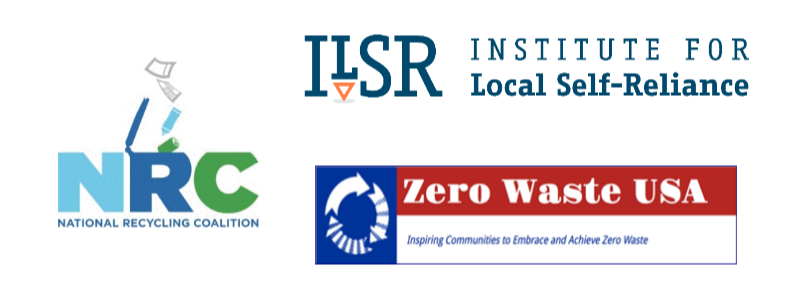
RECYCLING INFRASTRUCTURE PLAN RELEASED
(ILSR press release)
FOR RELEASE: July 15, 2021
Washington, D.C. – The Recycling Is Infrastructure Too Campaign released its first Recycling Infrastructure Plan today. There are a total of 50 initiatives and requests for funding of $3.3 billion in physical infrastructure, and $3.3 billion for Infrastructure Support Policies and Programs for the first year. Over a three year period, the Plan recommends a total investment of $16.3 billion. The National Recycling Coalition (NRC), the Institute for Local Self-Reliance (ILSR) and Zero Waste USA issued a request for the inclusion of “waste reduction, reuse, recycling and composting that will stem climate disruption, address racial justice, and create thousands of jobs throughout the country” in a March 31st press release. This Recycling Infrastructure Plan is the follow-up, with detailed policies and programs that should be included in the infrastructure discussions on Capitol Hill.
Recycling Infrastructure Needs
“The Plan presents the following Recycling Infrastructure initiatives, brought forward by a coalition of national reuse, recycling and composting experts, local government organizations and environmental leaders that desire to strengthen our national recycling infrastructure,” stated Richard Anthony, Vice President for Advocacy of Zero Waste USA. These initiatives are presented as investments in physical infrastructure, and then needed investments in supporting infrastructure needed to maximize the efficiency and use of these physical investments.
“Adding billions of dollars in economic activity to the American economy each year, the recycling circular economy is in its infancy, while recycling infrastructure is fractured and in need of repair much like U.S. bridges and road systems,” stated Bob Gedert, NRC President. With a combination of investments in physical infrastructure (like collection vehicles, carts and processing facilities) and supporting infrastructure (e.g. policies, programs, education and training), the American recycling infrastructure will grow significantly beyond the economic strength it currently is, creating the circular economy described by the Ellen Macarthur Foundation and already accomplished in large part in China.
Gedert further noted: “The dollar estimates for each initiative are for the first year of a proposed 3-year investment strategy. The focus for these investments is on one-time expenses that would modernize the industry, and then be sustainable thereafter based on fees for services. The recommended funding source for this infrastructure investment could continue to help fund supporting infrastructure thereafter, and also be used to help fund other climate change initiatives.”
Proposed Funding for Recycling Infrastructure
Ruth Abbe, President of Zero Waste USA highlighted that “this Plan also provides for innovative funding mechanisms for this infrastructure investment, to avoid the need to be supported solely by the General Fund of the U.S. Government. Many European nations have adopted significant fees on landfills of $20-40/ton to fund recycling programs and reduce greenhouse gases. This proposal recommends that the Federal government adopt a national $20/ton Producer Responsibility Fee on landfills and incinerators to help fund the above programs and contribute a new revenue source that would actually help meet the nation’s Climate Change goals at the same time.”
Gedert noted that “Extended Producer Responsibility (EPR) programs that hold producers fiscally responsible, but not physically responsible, for the proper management of products and packaging they produce according to the Zero Waste Hierarchy of Highest and Best Use are suggested to be used for hard to recycle items.” National or State level EPR programs should require a local government reimbursement from industry fees because local governments bear the first line of expense of products' end-of-life management costs.
These EPR programs provide their own funding for the development of needed infrastructure, so should be considered as self-contained, fully funded infrastructure programs. These programs don’t require a Federal investment of financial capital. Instead, these just require a Federal investment of political capital to establish these programs.
Neil Seldman from the Institute for Local Self-Reliance noted “There are also 5 Initiatives that reduce or eliminate Federal subsidies and will stimulate the development of infrastructure, once the marketplace adjusts. As a result, these should be considered as contributing to offsetting the cost of some of the proposed infrastructure investments. These programs reduce Federal investments of financial capital.”
Seldman continued “Other funding sources could include a fee on non-recyclable packaging and products that are toxic to the environment or create needless waste.” Examples include but are not limited to disposable floor cleaning pads, paper towels, and mercury switches in sneakers to create light.
Recycling Infrastructure Plan Webinar
Join on July 27th at 2 - 3:30 pm EDT to hear more details about this Recycling Infrastructure Plan. Register for this FREE Webinar and to get a link to the Plan at: https://us02web.zoom.us/webinar/register/WN_UAq6sNmkS8qyEKBpGNGViw
